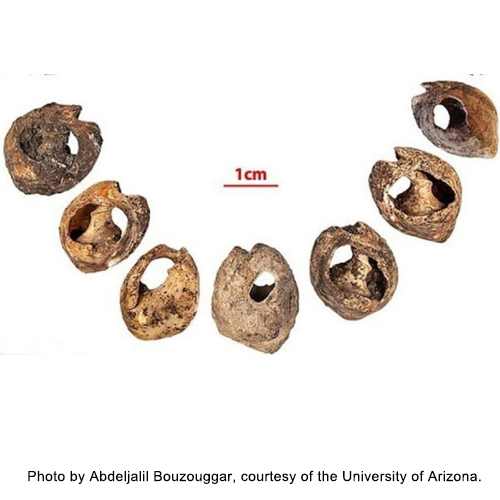Beaded jewelry took the summer trend by storm last summer with its rich colors and childish yet playful looks. Celebrities and socialites have all started. Almost all jewelry sub-categories, such as necklaces, mobile phone chains, rings, etc., are inseparable from the presence of beads.
At first glance, beaded seems to be a new thing that has only recently become popular, but this is not the case. The history of beading is much longer than we imagined, and there are many stories and values .
1. What is beaded?
In 2021, in a cave in Morocco's western desert, archaeologists discovered the world's oldest jewelry - a set of snail shell beads that date back about 140,000 years. Analysis revealed that each of the beads was perforated and had noticeable sanding marks, which are likely useing to make necklaces or earrings. This process of perforating materials and connecting them in series with needles or thin threads is called beading. The scientific name of beading is beading, and its crafts mainly include loom and non-loom weaving, threading, beading, beading crochet, and beading. The choice of beading material is vibrant; in general, as long as there are holes, it can be used as beading material.

Beaded is found in almost every culture in the world. Humans mainly used bones, shells, and wood as beading materials in the early days. With the popularity of glass-making techniques, glass beads appeared widely in beaded and beaded necklaces. In 1261, the production of complex glass beads began in Italy. By the 15th century, Venice, Italy, was the center of bead-making in Europe. As trade took place worldwide, glass beads began to spread around the world, and African and Native Americans began to use beads from Europe for their beading creations.
In various cultures, beading is used as an ornament to reflect social status or amulets to reflect religious beliefs. No matter what form and use it is, it plays the aesthetic and cultural carrier role in a certain period, reflecting different cultures—the people of the nation's pursuit of beauty and happiness.
2. Beading and the slave trade
Beading and the slave trade seem to be two unrelated terms, but they have a lot to do with each other. I don't know if you still remember a paragraph in the junior high school history book: From the end of the 15th century to the beginning of the 16th century, with the tremendous geographical discovery and the opening of new routes, the development of the world capitalism and the expansion of colonialism, European colonists made up for it. The lack of labor force comes to Africa that they have conquered. And they came to Africa by snatch, cheap exchange, or other methods (for example, European slave traders brought some industrial products or handicrafts and exchanged enslaved people with local chiefs in Africa. Sometimes one or two glass beads can be used. In exchange for an enslaved person), the enslaved people were shipped to the Americas, sold to plantations and mines, and then bought gold, silver, and various native products from the local area and brought them back to Europe to sell for huge profits. It is the infamous "slave triangle trade" in history.
The "glass beads" in this passage are the beading materials produced in Europe. Personal adornment is an ingrained part of African material culture. The glass bead trade combined a willingness to trade with indigenous peoples' fondness for ornaments. At the same time, glass beads were relatively cheap to produce, highly designable, and relatively easy to transport by land and sea. At the time, European merchants would also specialize in what different tribes preferred color palettes and bead types. Between the 16th and 20th centuries, beads became an important symbol of status in Africa and were a currency. Intricately crafted beads became family heirlooms, dowries, and funerary objects. Due to the increasing demand for beads, Venice, the bead production center in Europe, could not meet the huge market with all its efforts, so glass beads began to be mass-produced all over Europe. It says that European slave traders took advantage of the backwardness of glass manufacturing technology of the locals in America and Africa and their demand for beading to complete the bloody process of primitive accumulation of capital. Beading has involuntarily played an essential role in this shameful history.
3. Today's Beaded
Historically, beading has been a symbol of wealth and status, an item for religion and ritual, and an intermediary in the slave trade. Although its role has changed, its most basic decorative attributes have never changed. The variety of beading techniques, the freedom and flexibility of material selection, and the lower production threshold enable people to use it to make jewelry or create artistic creations easily. Today, if we search for beading on social media or shopping platforms, beading tutorials, links to beading materials, etc., will appear quickly.
In the 1870s, driven by the hippie movement, beaded jewelry was active in people's sights again. Today, the retro trend in the fashion circle has set off, and beaded jewelry will frequently appear on social media in the summer of 2021 with its lively and light look. Because of the flexibility and creative tolerance of beading and buying beaded jewelry, many people have started producing their own beaded creations (myself included). The production, development, and continuation of beads reflect historical information and reflect people's continuous aesthetic pursuit.
Contact: Lee
Phone: 008615812571762
E-mail: le@lerings.com
Whatsapp:008615812571762
Add: 3F,#4 ShangXing Road, XingAn ChangAn Town, DongGuan,China
We chat